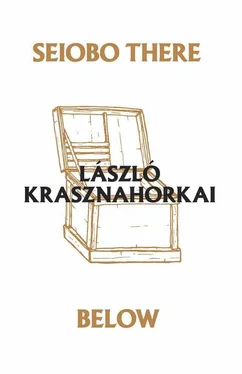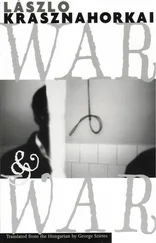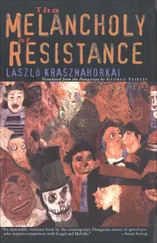Laszlo Krasznahorkai - Seiobo There Below
Здесь есть возможность читать онлайн «Laszlo Krasznahorkai - Seiobo There Below» весь текст электронной книги совершенно бесплатно (целиком полную версию без сокращений). В некоторых случаях можно слушать аудио, скачать через торрент в формате fb2 и присутствует краткое содержание. Год выпуска: 2013, ISBN: 2013, Издательство: New Directions, Жанр: Современная проза, на английском языке. Описание произведения, (предисловие) а так же отзывы посетителей доступны на портале библиотеки ЛибКат.
- Название:Seiobo There Below
- Автор:
- Издательство:New Directions
- Жанр:
- Год:2013
- ISBN:978-0811219679
- Рейтинг книги:4 / 5. Голосов: 1
-
Избранное:Добавить в избранное
- Отзывы:
-
Ваша оценка:
- 80
- 1
- 2
- 3
- 4
- 5
Seiobo There Below: краткое содержание, описание и аннотация
Предлагаем к чтению аннотацию, описание, краткое содержание или предисловие (зависит от того, что написал сам автор книги «Seiobo There Below»). Если вы не нашли необходимую информацию о книге — напишите в комментариях, мы постараемся отыскать её.
Seiobo — a Japanese goddess — has a peach tree in her garden that blossoms once every three thousand years: its fruit brings immortality. In
, we see her returning again and again to mortal realms, searching for a glimpse of perfection. Beauty, in Krasznahorkai’s new novel, reflects, however fleetingly, the sacred — even if we are mostly unable to bear it.
shows us an ancient Buddha being restored; Perugino managing his workshop; a Japanese Noh actor rehearsing; a fanatic of Baroque music lecturing a handful of old villagers; tourists intruding into the rituals of Japan’s most sacred shrine; a heron hunting.… Over these scenes and more — structured by the Fibonacci sequence — Seiobo hovers, watching it all.
Seiobo There Below — читать онлайн бесплатно полную книгу (весь текст) целиком
Ниже представлен текст книги, разбитый по страницам. Система сохранения места последней прочитанной страницы, позволяет с удобством читать онлайн бесплатно книгу «Seiobo There Below», без необходимости каждый раз заново искать на чём Вы остановились. Поставьте закладку, и сможете в любой момент перейти на страницу, на которой закончили чтение.
Интервал:
Закладка:
Mr. Arlango could have said that, contrary to all expectations, the picture was not at all in as bad a condition as would have been expected at first sight, and he could have said that this was due to the picture’s already having been restored five or six decades previously; for if, within the internal parlance of Mr. Arlango, this earlier restoration could be termed philistine and irresponsible, it was nonetheless helpful, very helpful, that the original canvas had been backed up against and then stretched onto another canvas, and the reinforced picture had been placed again upon a frame; they, however, had made use of three unacceptable procedures, as it happened; for one, Signor Arlango muttered to himself, they did not take into account how the paint was cracking and peeling away from the canvas; two — he counted to himself on his fingers — they retouched, indeed repainted the right eyebrow of Christ our Lord, the hair of Christ our Lord, and the shoulder of Christ our Lord; and three, grabbing his thumb, index and middle fingers and squeezing them together in rage, they had simply smeared the surface of the painting with some cheap junk, some kind of lacquer-like substance, which in the course of time had oxidized and yellowed, and with that, the fate of the picture was sealed, because that for the most part ruined it, more precisely — and with the increasing inner force of his words he punched into the air — they falsified the original effect of the painting, chopping up and finally destroying the picture itself, because this had caused the entire artwork to change, which is unforgivable on the part of a restorer, whose business it is precisely to give back to the work the spirit of its original creation, but these ones, Mr. Arlango motioned with his hand resignedly, they could not have been restorers, a restorer would never do such a thing, methods such as these are used only by amateurs, by dilettante art-bunglers, and pronouncing these words — dilettante art-bunglers — Mr. Arlango calmed down; because when in the course of his work he came into contact with dilettantes, he pronounced his judgment, named them for what they were, and that was that, he was finished, no longer bothering with the matter, only with how to render them harmless, if it was still possible; at such times as now, he fell into deep concentration, looking at the picture for hours on end, thinking through what was to be done, what work must be completed, in what order it should proceed, what materials to use, what examinations to be performed — then he set to work, and at such times it really was not desirable to disturb him, for that matter it was not desirable to disturb him in general, as Dr. Agnese Chiari had already experienced in her own case; so she couldn’t have known what was going on in the workshop, nothing about the examinations, about what materials were being used, what working methods, and in what order they were being performed — so when the day arrived, that is to say when the examinations had begun and the picture was under the illumination of a special X-ray machine, the result was so surprising that even Signor Arlango hardly dared risk not informing the client, because he knew what was at stake, and it was hardly incidental — to establish, in other words, who was the artist — although looking at the picture closely, it had already been clear to him, from the nature of the draftsmanship as well as the varying quality of the details, that the work was the result of the effort of not one, but two artists; but he himself was quite surprised as — in the course of X-raying the picture, perceiving the difference in the pigments as well as the layers of imprimatura and gesso lying on top of each other, trying to determine their quality, condition, and kind — he glimpsed the name, the signature painted in the usual manner of the cinquecento onto the wooden board itself, it was placed deliberately — or in any event, before the painting of the work had begun — into the pictorial space: then he no longer hesitated, he notified the Confraternita to send someone, for he had something important to show them on the picture, so that after Dr. Agnese Chiari from the San Rocco had arrived once again, Mr. Arlango merely placed the picture behind the X-ray device, chased his guest out of the workshop, pressed the remote control in his hand, withdrew the slide, and developed it, and only then did he call the guest waiting in the corridor back in, sat her down in a chair, but said nothing to her, altogether he said not one word, only snatched up the X-ray image now hanging from a string tautened across the workshop window and handed it to her, withdrawing wordlessly to his work table, and he made as if he were scraping away at something again; but all the while he was observing the client, who looked at the picture for a while in silence, then got up from her chair, coming closer to see better in the light, but there was no doubt: in the upper left-hand corner of the X-ray image was written legibly the name VICTOR and on the other side BELLINAS, and Dr. Chiari just looked, and she didn’t want to believe what she was seeing, because it just couldn’t be, and she just looked, looked at the name, her gaze now fixed on Victor, now on Bellinas, it wasn’t possible that this almost nameless nobody could have. . it was unimaginable, nobody was going to believe her, but still the board of San Rocco, all waited with bated breath for her ceremonious announcement: my dear colleagues, it has been determined, to the exclusion of all doubt, that the creator of this work is Tiziano, or my dear colleagues, now there is no doubt whatsoever that the picture was painted by Giorgione, or possibly, I have the pleasure to inform you that, due to the result of our investigations, the creator of this exceptional work shall no longer be the subject of uncertainty, for it has been demonstrated that the author is Giovanni Bellini and no one else — except that it was someone else, Agnese Chiari now thought to herself, and consternated, thought it best to sit back down in the chair, because the name was finally so clearly legible, Victor Bellinas, who was none other than Bellini’s — the great Bellini, Giovanni’s — most indefatigable assistant, about whom — Dr. Chiari tried to call forth from her memory — we know almost nothing, so insignificant was he; of course, there are perhaps one or two pictures that can be attributed to him, “Crocifisso adorato da un devoto” in the Carrara Museum in Bergamo, and maybe a few others; a fresher memory of a painting, perhaps of two young men, loomed forth from Dr. Chiari’s memory, but in reality he was not known as a painter, only a painter’s assistant, to whom Bellini left part of his estate, that is after the loss of his wife and the decease of his son, and he did not marry again, he had no heirs, for his bad relationship with his brother Gentile, as well as his even worse relationship with his father Jacopo, was common knowledge at the time, so for him it would have seemed most fitting to adopt this faithful, industrious, trustworthy assistant, this Vittore di Matteo, as he was originally called, to adopt him simply as his grandson and bequeath to him the most valuable of what would remain after he was gone, that is to say the workshop, counted as the most illustrious in Venice in 1516, when Bellini died; this was bequeathed as an inheritance to the disciple of Venice’s most famous painter as the chief asset along with, Agnese Chiari thought to herself — it now seemed, one or two unfinished pictures; she now rose from her seat and, as the master restorer continued to scrape away exhibiting the greatest possible indifference to the matter, she went over to the picture again, looked at it more thoroughly, and perhaps not so accidentally reached the sudden conclusion as the workshop’s master had reached at the very beginning, for she now saw at once that the head, well, it was somehow different from the whole, ravishing in and of itself, while everything else seemed to have been painted in a completely divergent, greatly inferior fashion: it was a flash, but Agnese Chiari understood instantly that the head was Bellini’s, and the rest had been completed after the death of his great mentor by Vittore di Matteo, called Belliniano in his honor, according to his own talent, which was not exactly scandalous but just in no way comparable to the genius of the creator of the head; there stood the envoy of San Rocco and she did not know what to do; should she try to talk with this dreadful Mr. Arlango and ask his opinion — what for? — she cast aside the idea, it would be enough to persuade the council of the Confraternita of San Rocco to swallow this surprising result, and accept that life is surely a little more complicated than those present here, the current generation, would like to admit; that is to say the picture is completely immaculate, Agnese Chiari explained to the council, enthusiastically raising again and again the enlargement taken from the X-ray image, it is immaculate in every possible meaning of the word, she said, in once sense because master Arlango, after necessary chemical testing, mixed a certain solvent with which the “protective lacquer” originating from the unknown yet dilettantish hand was removed, and now it shines forth in its own immaculate, its own original character; but it is immaculate in the sense too that we now know, beyond a shadow of a doubt, who painted it, at which point the members of the council exchanged significant glances and looked at the art historian with great expectation, and if they were not made unequivocally happy by what they heard, it was because, now was it Bellini — or not Bellini? — they asked each other; do you understand? the question went back and forth, I for one don’t, came the answer from here and there, and as Dr. Chiari could see just how difficult it was for the council members to take in the truth, she repeated again and again that the head, and her voice resounded triumphantly in the room — was Bellini’s; the picture, however, she continued, originates from various hands; it can be hypothesized that this certain Belliniano found this marvelous head among the canvases that had been begun by his master in the workshop bequeathed to him, and cleverly, so that he could be there and yet not be there — he could hardly bear to write the name of his own person, having finally emerged from his master’s shadow, and yet he could not bear not to write it — he accordingly wrote his own name, dividing it between the left and the right sides of the head, and then painted over it, in other words concealing the entire thing; for surely he knew well that he could sell it as a Bellini painting for a huge sum anywhere and anytime, whereas an unfinished Bellini, actually a hardly started Bellini — not to mention, if he were to betray that apart from the head he had painted the entire picture — wouldn’t get him anything, only a few coins, so he painted what was missing as best he could; the three Greek letters on either side of the head, the naked torso, the shoulder, the two hands as they intertwine in the front of the picture, and he created for all of this a dark background, so that the face, whose enthralling power he would never have been able to conjure up himself, would burst forth as it were from the darkness, with its boundless docility, something like that occurred, it is certain — Dr. Chiari reported to the members of the council — and so the endless dilly-dallying could finally come to an end, at which the council members, slightly confused, began to nod their heads, and consented to everything that the art historian recommended, namely that the painting should not be put back into its old corner in the Albergo, but that it should be put on a stand in a prominent spot in the great hall, and an article should be written about it, because they could be completely certain — Agnese Chiari reassured her colleagues — that the art historians, if they had not done so before, would now take notice of this picture, so let it be displayed with all the respect due to a great creator, it should be lit with a spotlight and then they would see that the name of S. Rocco would become even more illustrious, for it was not any old finding that they had been able to discover with this Vittore, mark my words, repeated Dr. Chiari, everyone will be talking about this; in which, however, the scholar was greatly mistaken, because in total a notice of a few lines was published in a professional journal for restorers, penned by an unknown art historian, Giovanna Nepi Sciré, and the whole thing remained confined to the pages of Restituzioni 2000, which, because of the far too specialized nature of the journal’s orientation, could not reach the personages most affected, so that they knew nothing of this discovery, not Tempestini, not Goffer, not Belting; and the wider public, finally, knew nothing at all, so that now, standing in the square before the San Rocco in the sunlight that filtered through the iron gate, as he made ready to enter the building at last and seek out the work for the second time in its usual spot; inside, on the ground floor, the vendor behind the ticket desk awaited the tourists, continually arranging the exact same postcard with the exact same signature taken from the famous painting, exactly as eleven years ago, when he had come here for the first time, had entered and come into sudden contact with the Dead Christ, up there on the second floor, the little room opening up on the left from the wide landing, in the corner of the Albergo, not even lit by a single light.
Читать дальшеИнтервал:
Закладка:
Похожие книги на «Seiobo There Below»
Представляем Вашему вниманию похожие книги на «Seiobo There Below» списком для выбора. Мы отобрали схожую по названию и смыслу литературу в надежде предоставить читателям больше вариантов отыскать новые, интересные, ещё непрочитанные произведения.
Обсуждение, отзывы о книге «Seiobo There Below» и просто собственные мнения читателей. Оставьте ваши комментарии, напишите, что Вы думаете о произведении, его смысле или главных героях. Укажите что конкретно понравилось, а что нет, и почему Вы так считаете.












